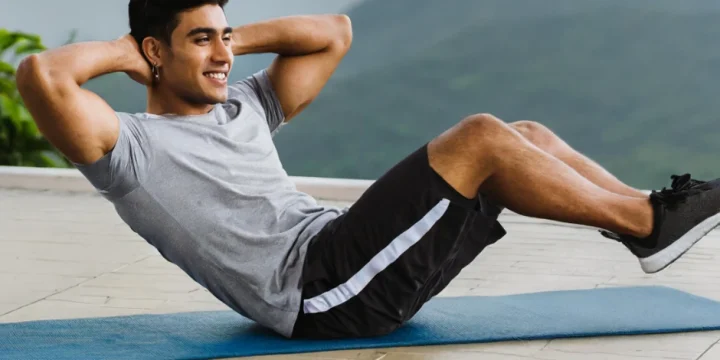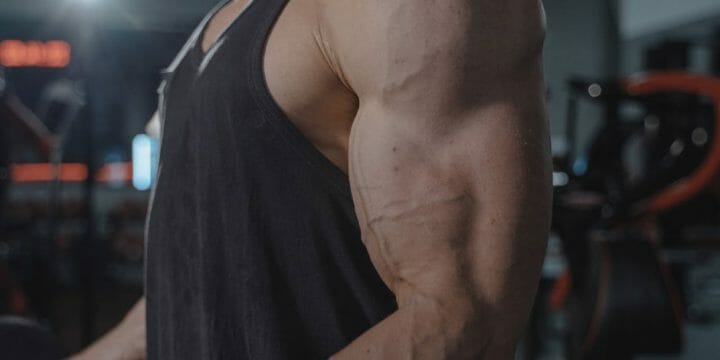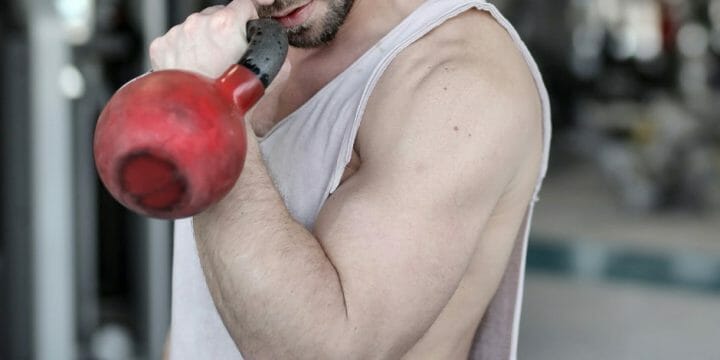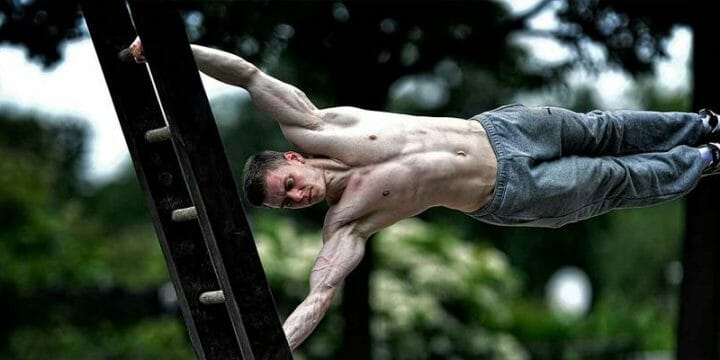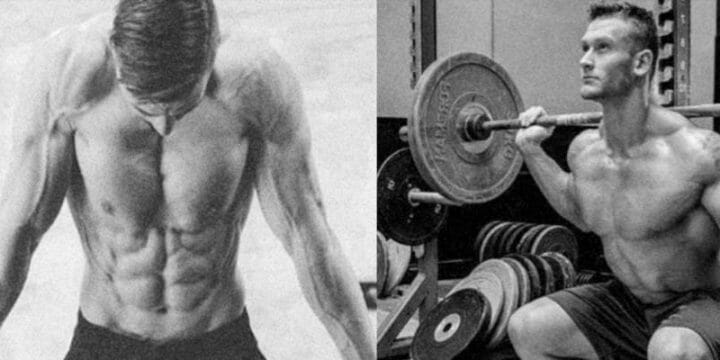Big biceps are paramount, and everyone looks to grow them.
As a professional coach, I've had clients and readers ask if building bigger biceps using calisthenics is possible.
I took my time to research the anatomy of the biceps and worked with a few colleagues to come up with the best calisthenics biceps exercises.
In this article, I will provide everything you need to know about the biceps and a guide on how to grow big biceps with calisthenics.
Quick Summary
- The seven most effective calisthenics workouts for bicep development are pull-ups, reverse grip push-ups, chin-ups, one-arm chin-up negatives, commando pull-ups, horizontal bodyweight ring curls, and resistance band bicep curls.
- These exercises are diverse in their approach to bicep training, utilizing various grips and bodyweight techniques to strengthen and build bicep muscles effectively.
- According to the Journal of Clinical Medicine Research, the biceps long head is crucial for shoulder joint stability, especially during the first 30 degrees of arm elevation.
- In my opinion, these calisthenics exercises are not only highly effective for bicep development but also promote functional strength and fitness, making them a vital part of any comprehensive training program.
The Best Calisthenics Bicep Workouts

1. Pull-ups
"Mastering this exercise is a worthwhile challenge regardless of your fitness objectives. It's an essential gym-building block workout that benefits bodybuilders, CrossFitters, and overall fitness enthusiasts alike."
- Andrew Heffernan, Certified Strength & Conditioning Specialist
In addition to developing your back, shoulders, and chest, pull-ups are among the best biceps-building workouts you can perform using minimal equipment.
If you cannot access quality pull-up bars, you may use your creativity and connect a set of gymnastics rings to a part of playground equipment, a tree branch, or a soccer goal.
In my coaching experience, I've seen pull-ups not only strengthen the upper body but also significantly improve the bicep muscle tone in my clients.
How to perform:
- Let your body hang from the bar with your hands shoulder-width apart, palms facing outward, and your arms straight (ideally with both feet off the floor).
- Pull yourself up slowly, keeping your body from swinging back and forth until the chin exceeds the level of the bar.
- Lower yourself while maintaining the same level of tension.
- Repeat for the desired number of reps.
2. Reverse Grip Push-up
This push-up variation engages the biceps by requiring them to stabilize the elbow in a supinated position and by using a forward lean for shoulder flexion.
Proper form and starting position are crucial for the effectiveness of this exercise.
Having incorporated reverse grip push-ups into my routines, I've noticed a marked increase in both bicep strength and stabilization among my trainees.
How to perform:
- Put your hands shoulder-width apart on the floor, fingers pointing backward.
- Adopt a push-up position with your core taut, glutes engaged, and spine neutral.
- Lean forward until your shoulders are directly in front of your arms. That's the only way to get your biceps to contract.
- Do a push-up from here, ensuring that your elbows are tight to your body.
- It is critical to keep a forward lean during this workout.
- Repeat for the desired number of reps.
3. Chin-up
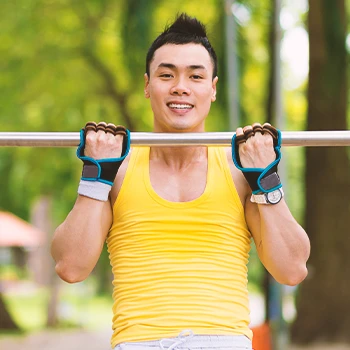
Some individuals get chin-ups and pull-ups mixed up since they use the same gear and have a similar range of motion.
Chin-ups require shoulder extensions and an underhanded grip, whereas pull-ups demand shoulder abductions and an overhand grip.
Chin-ups also target your biceps more than pull-ups, which may explain why you can perform more chin-ups than pull-ups.
Chin-ups, like pull-ups, can be performed on any bar or supporting beam, at a gym, at home, or in the park.
From my training sessions, chin-ups have consistently proven to be more effective for direct bicep engagement compared to pull-ups.
How to perform:
- Hold the bar shoulder-width apart, hands facing outward like you would for a pull-up.
- Lift your body higher towards the bar, keeping your core engaged until your chin is higher than the bar and your elbows are completely bent.
- Drop yourself back down with steady movement until your hands are straight again.
- Repeat for reps.
4. One-Arm Chin-up Negatives
Regular chin-ups effectively work the biceps, but one-arm chin-ups take it a step further, challenging the muscles with an underhand grip and additional arm support.
This advanced exercise involves a controlled lowering of the body, engaging multiple muscle groups, and demanding precise shoulder blade alignment.
For beginners, modifying the movement by slightly bending the non-working elbow can reduce difficulty, providing more support to the active arm.
In my experience, beginners who start with modified one-arm chin-up negatives progress faster in bicep strength than those who don't.
How to perform:
- Use a bench or chair to get to the top chin-up stance (hands facing you - supinated).
- Move one hand as far to the side as possible while still hanging on to the bar.
- Engage your core and gradually lower yourself down from here.
- Keep the elbow near your body and move slowly.
- Concentrate on the bicep-mind-muscle connection as you drop.
- Employ a full range of motion, then extend the elbow to the bottom.
- Return to the starting position and perform with the other hand.
- Repeat for the desired number of reps.
5. Commando Pull-up
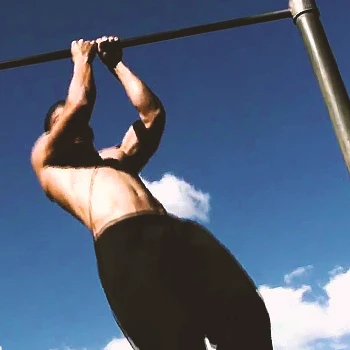
Commando pull-ups are a great workout that emphasizes elbow and shoulder flexion.
I've found commando pull-ups to be an excellent addition for advanced clients looking to challenge their biceps and upper body coordination.
How to perform:
- With a neutral grip, grab the pull-up bar (stand perpendicular to the bar with both palms facing each other).
- Experiment with the spacing between your arms to determine what feels comfortable (the closer you are, the better).
- To begin, flex your elbows and lift your torso toward the bar.
- Bring your head to one side of the pull-up bar and contact the bar with your trap muscle.
- Slowly drop yourself back to your starting position.
- Bring the head to the other side of the pull-up bar on the following repetition.
- Perform this exercise for reps, concentrating on completing the eccentric slowly.
6. Horizontal Bodyweight Ring Curls
Ring bicep curls are one of the best bodyweight bicep exercises.
You’ll use the rings to isolate the biceps.
They are also referred to as upside-down curls.
You may use the rings to develop both elbow flexion and supination.
When I introduced horizontal bodyweight ring curls into my classes, I observed a noticeable improvement in bicep isolation and growth.
How to perform:
- Align yourself horizontally underneath the rings and use a neutral grip to grab them (palms facing each other).
- On the ring handles, your arms should be shoulder-width apart.
- Maintain a straight spine, a firm core, and engaged glutes.
- Kneel and maintain your legs flat on the ground.
- Your body should ideally be in a straight line, with your knees at a 90-degree angle.
- Curl both your arms and bring the forehead towards the rings.
- Rotate both hands to the top so that they are supinated.
- Keep your elbows tight to your body, and keep your hips from sagging.
- At the top, pause and feel the bicep peak contraction.
- Lower the eccentric gradually and return to the starting position.
- Repeat for the desired number of reps.
7. Resistance Bands Biceps Curl
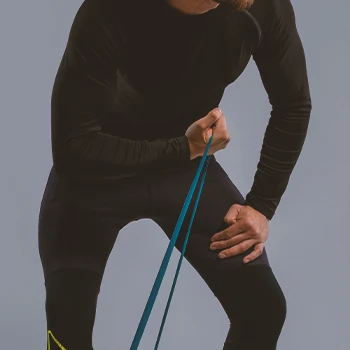
You must acquire resistance bands if you don't have rings or a bar. You can perform many bicep curl exercises with bands just as you would with dumbbell curls.
Focus on maintaining tension and the mind-muscle connection in your workouts.
While dumbbell curls offer the benefit of using heavier weights, resistance band curls provide consistent tension, making them a valuable addition to your routine.
Incorporate variations like preacher curls and seated hammer curls for progression and diversity.
Incorporating resistance band bicep curls has been instrumental in providing my clients with versatile, tension-focused workouts.
How to perform:
- Standing in a neutral posture on the band, hold the handle or end of the resistance band in each hand and begin with both hands straight down, palms facing forward.
- Remember not to lock the elbows to your sides, as with dumbbell curls.
- You may do double or single-arm curls like dumbbells, but don't let the resistance band snap back eccentrically.
- Repeat for the desired number of reps.
Anatomy of the Biceps
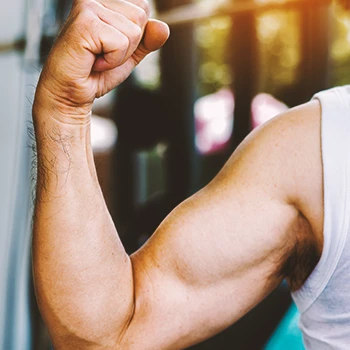
The biceps brachii, or biceps, is a big, thick muscle located on the ventral side of the upper arms. In my years of coaching, understanding the biceps anatomy has been crucial for designing effective workouts that target both heads of this significant muscle.
The muscle has two heads: a short and a long head.
The biceps brachii long head is positioned on the lateral side, whereas the short head is on the medial edge, according to the Journal of Clinical Medicine Research [1].
The biceps brachii act across three joints, producing motions in the glenohumeral, radio-ulnar, and elbow joints.
The muscle has two heads: the short and long heads.
- The short head develops from the tip of the scapula's coracoid process [2].
- The long head derives from the scapula's supraglenoid tubercle.
Both heads run distally and form a muscular belly before tapering over the anterior portion of the elbow and inserting into the radial tuberosity and forearm fascia through the bicipital aponeurosis [3].
The biceps' primary functions are forearm flexion and supination (external rotation).
This is aided partly by the muscle's 90-degree rotation as it attaches to the radius.
While the biceps muscle is the most visible upper arm muscle, its primary role is to help and support the deeper brachialis muscle when raising or lowering the forearm, based on the study published in PubMed [4].
The brachialis is the strongest elbow flexor without supination; nevertheless, it loses mechanical momentum with supination and elbow flexion [5].
The bicep brachii plays a minor role in shoulder flexion.
According to the Journal of Clinical Medicine Research, the biceps long head is supposed to improve the dynamic stability of the shoulder joint, but only during the first 30 degrees of elevation [6].
This role is essential in allowing people to bear heavy weights while their arms are stretched downward.
Understanding the anatomy of the biceps brachii, a two-headed muscle, sheds light on its multifaceted functions, including elbow flexion, forearm supination, and shoulder flexion. This knowledge can help in designing workouts that target the biceps more comprehensively and effectively.
Tips for Calisthenics Biceps Workouts

Proper Warm-up
Overloading a specific muscle area, especially one as tiny as the biceps, can be harmful if the loading is not appropriate for the ability level or if correct arm warm-ups are not performed before the calisthenics bicep exercise.
I always emphasize proper warm-ups in my sessions, as they prepare the biceps for intense workouts and reduce the risk of injury.
And by proper, I mean exercises that prepare you for impending motion.
Although aerobic activity can help you elevate your heart rate to perform better, it will not suffice as a warm-up for our purposes.
Pull-apart and regular push-ups can be added to the warm-ups.
Avoid Overtraining
The biceps, smaller compared to the triceps, have a limited capacity for overwork, emphasizing the importance of balanced training.
While they are engaged in various upper body exercises, it's crucial to avoid overtraining.
Aim for two bicep-focused sessions per week, increasing to three for more advanced individuals.
Incorporating the described calisthenics workouts can effectively stimulate bicep growth.
From my experience, balancing bicep workouts with rest is key, as overtraining can lead to diminished results and increased injury risk.
Full Range of Motion
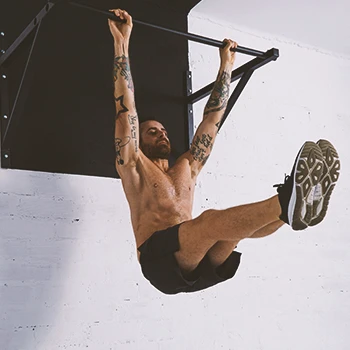
Bodyweight exercises like chin-ups, done with a shoulder-width grip, effectively strengthen and build your biceps in a calisthenics routine.
Ensuring a full range of motion in these exercises is crucial for optimal muscle activation and to prevent injury or misalignment.
I've seen significant improvements in muscle development when my clients focus on the full range of motion, especially in bicep-focused exercises.
Concentrating on some key points makes achieving a complete range of motion simple:
- Beginning from a good place with a good form.
- Using the targeted muscle group to reach the goal.
- Regressing to a variation appropriate for your skillset.
These three actions can increase the efficiency and efficacy of any task that requires more than simply biceps training, such as lunging, pushing, overhead pressing, and pulling.
Mind-Muscle Connection
"The mere act of intentionally feeling a muscle function through its complete range of motion, known as "attentional concentration" (or, more commonly, the "mind-muscle connection"), can improve muscle fiber activation and recruitment."
- Trevor Thieme, Certified Strength & Conditioning Specialist
The mind-muscle connection describes how a person's mental attention to the target muscle(s) may help them grow physical strength and muscle.
As a result, it is frequently seen as one aspect of several disciplines of performance enhancement, such as bodybuilding and weightlifting, athletic training, and any other activity in which muscle control is essential.
Encouraging my clients to focus on the mind-muscle connection has consistently led to more effective workouts and better muscle engagement.
Maintaining a mind-muscle connection can assist you in enhancing bicep growth with bodyweight exercises for your intended purpose.
This entails concentrating on bicep activation during exercise.
To maximize muscle growth in calisthenics bicep workouts, it's essential to focus on Time Under Tension (TUT), ensuring that muscles are engaged for an optimal duration, which is key for effective muscle gain. This balance between exercise intensity and muscle tension duration can significantly impact the effectiveness of your workout.
FAQs
Can You Grow Biceps With Calisthenics?
Yes, you can use a calisthenics bicep workout to grow your biceps. You have to focus on the correct exercises and perform them in the right form. You should mix and match a range of pulling exercises to achieve optimum results.
Including calisthenics biceps exercises in your bicep workout can be highly effective, and exercises like push-ups and chin-ups are excellent choices for targeting the biceps using body weight. These exercises are among the best calisthenic exercises for building strong and defined biceps without the need for weights.
What Calisthenics Give You Bigger Arms?
The calisthenics that give you bigger arms are push-ups, dips, pull-ups, and bodyweight rows.
Do Biceps Grow With High Reps?
Yes, biceps grow with high reps. The biceps should be exercised with rep ranges ranging from 5 to 20 repetitions to enhance strength, muscular growth, and general muscle development.
References:
- https://www.ncbi.nlm.nih.gov/pmc/articles/PMC5505302/
- https://www.ncbi.nlm.nih.gov/pmc/articles/PMC2878700/
- https://www.ncbi.nlm.nih.gov/books/NBK519538/
- https://pubmed.ncbi.nlm.nih.gov/17229281/
- https://www.ncbi.nlm.nih.gov/books/NBK551630/
- https://www.ncbi.nlm.nih.gov/pmc/articles/PMC5505302/
About The Author
You May Also Like
